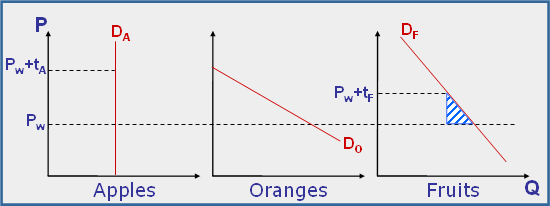Rationale for Partial Equilibrium modeling
SMART, the market access simulation package included in WITS, is a partial equilibrium modeling tool. While there are many different approaches to market access analysis, adopting the partial equilibrium one has a number of advantages. It also has a number of its disadvantages that the analyst ought to bear in mind.
Definitions: partial equilibrium implies that the analysis only considers the effects of a given policy action in the market(s) that are directly affected. That is the analysis does not account for the economic interactions between the various markets in a given economy. In a general equilibrium setup all markets are simultaneously modeled and interact with each other.
The advantages of partial equilibrium modeling
The main advantage of the partial equilibrium approach to Market Access Analysis is its minimal data requirement. In fact, the only required data for the trade flows, the trade policy (tariff), and a couple of behavioral parameters (elasticities). This can therefore take advantage of the rich WITS datasets which contain all of those.
Another advantage (which follows directly from the minimal data requirement) is that it permits an analysis at a fairly disaggregated (or detailed) level. For example, it allows the study of the effects of the liberalization of “brown rice? imports by Madagascar, a level of aggregation that is neither convenient nor possible in the framework of a general equilibrium model. This also resolves a number of �“aggregation biases.?
Illustrating the aggregation bias

The graphics above illustrates an aggregation bias by considering 2 products (Apples and Oranges) falling into the same product category (Fruits). Apples face a tariff tA but demand for apples (DA) is perfectly inelastic. Consequently, tA does not entail welfare cost on the Apples market since it does not affect the level of imports. On the Oranges market, demand is somehow elastic but imports face no tariff. Again, there is no welfare cost. Therefore, the protection on the Fruits market is clearly not associated with welfare cost when analyzing at the its component level, while analysis implemented at the Fruits (aggregated) level would conclude that there is welfare cost the blue stripe triangle because of the aggregation bias.
By the same logic, the partial equilibrium may allow the analysis of the likely impact of trade agreements like the Doha round more accurately, as the negotiations are conducted at a very disaggregated level.
In general, by virtue of their simplicity, partial equilibrium models tend to be more transparent and easy to implement. Modeling is straightforward and results can be easily explained.
The disadvantages of partial equilibrium modeling
The partial equilibrium approach also has a number of disadvantages that have to be kept in mind while conducting any analysis. Since it is only a �“partial? model of the economy, the analysis is only done on a pre-determined number of economic variables. This makes it very sensitive to a few (badly estimated) behavioral elasticities.
Due to their simplicity also, partial equilibrium models may miss important interactions and feedbacks between various markets. In particular, the partial equilibrium approach tends to neglect the important inter-sectoral input/output (or upstream/downstream) linkages that are the basis of general equilibrium analyses. It also misses the existing constraints that apply to the various factors of production (e.g., labor, capital, land�…) and their movement across sectors.
Next: SMARTTheoretical Framework
WITS Online Help
The World Bank, 2010